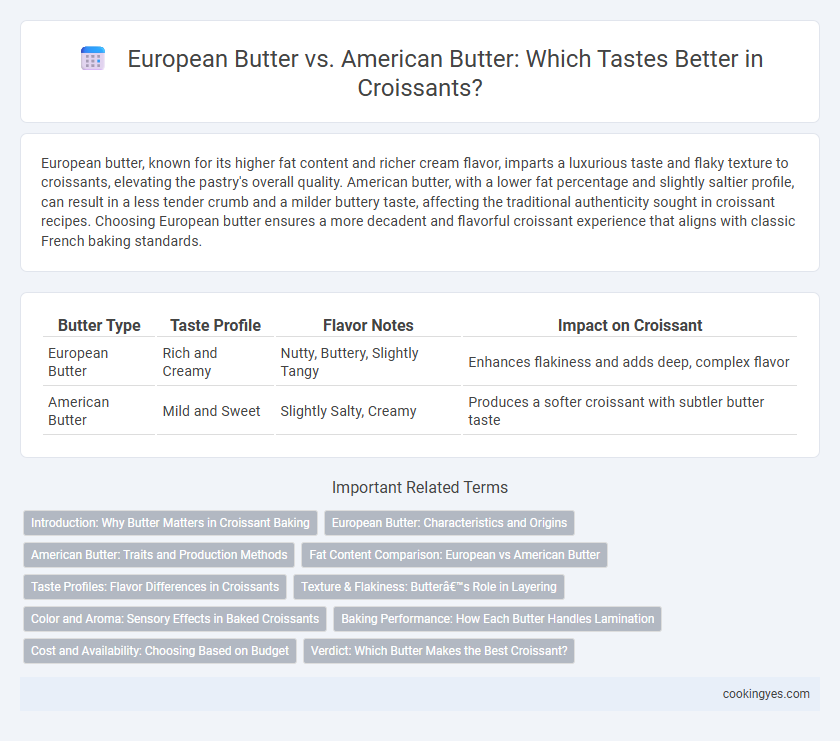European butter, known for its higher fat content and richer cream flavor, imparts a luxurious taste and flaky texture to croissants, elevating the pastry's overall quality. American butter, with a lower fat percentage and slightly saltier profile, can result in a less tender crumb and a milder buttery taste, affecting the traditional authenticity sought in croissant recipes. Choosing European butter ensures a more decadent and flavorful croissant experience that aligns with classic French baking standards.
Table of Comparison
| Butter Type | Taste Profile | Flavor Notes | Impact on Croissant |
|---|---|---|---|
| European Butter | Rich and Creamy | Nutty, Buttery, Slightly Tangy | Enhances flakiness and adds deep, complex flavor |
| American Butter | Mild and Sweet | Slightly Salty, Creamy | Produces a softer croissant with subtler butter taste |
Introduction: Why Butter Matters in Croissant Baking
European butter, known for its higher fat content and lower moisture, creates a richer and flakier croissant texture compared to American butter, which contains more water and less fat. The distinct creamy flavor of European butter enhances the buttery aroma and mouthfeel, essential for authentic croissant taste. Choosing the right butter affects the dough's lamination process, crucial for achieving the delicate layers and melt-in-the-mouth softness characteristic of traditional French croissants.
European Butter: Characteristics and Origins
European butter, renowned for its higher fat content (typically 82-86%) and creamier texture, is essential for achieving the rich, flaky layers characteristic of authentic croissants. Originating from countries like France, Belgium, and Denmark, it is produced using traditional churning methods and cultured cream, which imparts a distinctive tangy and slightly nutty flavor. This complexity in taste and superior melting properties make European butter the preferred choice among bakers seeking to replicate the delicate, buttery depth of classic European pastries.
American Butter: Traits and Production Methods
American butter, known for its higher water content and slightly lower fat percentage compared to European butter, yields a lighter, less rich croissant texture. Its production often involves pasteurized cream and churning methods that emphasize consistency and spreadability, contributing to a milder flavor profile. This results in croissants with a tender crumb and subtle buttery notes, preferred for everyday consumption and a less intense buttery taste.
Fat Content Comparison: European vs American Butter
European butter typically contains between 82-85% fat, providing a richer, creamier texture that enhances the flaky layers of croissants with a deep, buttery flavor. In contrast, American butter usually has around 80-82% fat, resulting in a slightly lighter taste and less pronounced richness in the pastry. This higher fat content in European butter contributes significantly to the superior flavor and tenderness prized in traditional French croissants.
Taste Profiles: Flavor Differences in Croissants
European butter in croissants delivers a rich, nutty flavor with higher butterfat content, creating a more complex and creamy taste profile. American butter tends to have a milder butter flavor with less sweetness and lower fat, resulting in a lighter, less intense buttery taste. This difference significantly influences the croissant's overall flavor depth, with European butter enhancing the pastry's richness and melt-in-the-mouth texture.
Texture & Flakiness: Butter’s Role in Layering
European butter, with its higher fat content ranging from 82-85%, creates a richer, flakier texture in croissants by promoting distinct and crisp layers during lamination. American butter typically contains about 80% fat, resulting in a softer dough that produces a less pronounced flakiness and a more tender crumb. The higher butterfat and water content in European butter allow for better steam generation, enhancing the lift and separation of layers essential to croissant lamination.
Color and Aroma: Sensory Effects in Baked Croissants
European butter, often crafted from cultured cream, exhibits a deeper yellow hue and a more pronounced, tangy aroma that enhances the rich, layered flavor of croissants. American butter typically has a paler color with a milder, creamier scent, resulting in a subtler taste profile when baked into pastries. The vibrant color and robust aroma of European butter contribute to croissants with a more complex sensory experience, highlighting the buttery notes and golden crust.
Baking Performance: How Each Butter Handles Lamination
European butter, with its higher fat content of around 82-85%, delivers superior lamination performance in croissants by creating distinct, flaky layers and enhancing flavor richness. American butter typically contains about 80% fat and more water, which can lead to less rise and slightly less crispness during the lamination process. The higher moisture in American butter may cause dough to be stickier, affecting the precise folding required for optimal lamination in croissant baking.
Cost and Availability: Choosing Based on Budget
European butter, known for its higher fat content and rich flavor, typically costs more than American butter due to traditional production methods and limited availability outside Europe. American butter tends to be less expensive and widely accessible, making it a budget-friendly choice for croissant bakers prioritizing cost-effectiveness. Selecting between European and American butter depends on balancing the desired buttery richness against budget constraints and local market availability.
Verdict: Which Butter Makes the Best Croissant?
European butter, typically containing 82-85% butterfat, imparts a richer, creamier flavor and flakier texture to croissants compared to American butter, which usually has around 80% butterfat. The higher butterfat content and lower water content in European butter contribute to superior lamination and a more delicate, buttery taste. For the best croissant, European-style butter is the preferred choice among bakers aiming for authentic French pastry quality.
European Butter vs American Butter for Taste Infographic

 cookingyes.com
cookingyes.com